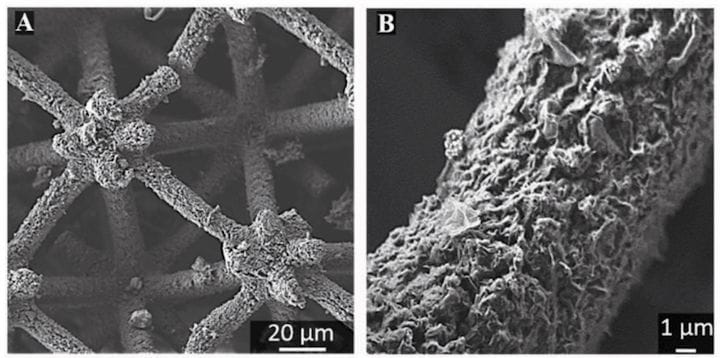![3D printed graphene micro architectures [Source: DOI: 10.1039/c8mh00668g]](https://fabbaloo.com/wp-content/uploads/2020/05/image-asset_img_5eb0a8928ceea.jpg)
Graphene is one of those wonder materials you hear about, but somehow can never be properly 3D printed.
This material is truly a wonder: it has astonishing strength, incredible electrical conductivity and is made from common carbon, found everywhere. Its amazing properties derive from its structure: it’s essentially a sheet of carbon atoms that are bonded together very strongly using fundamental physical forces.
But those benefits belie the challenges in working with the material.
It’s possible to make larger sheets of graphene using several techniques, but the graphene molecules are randomly arranged and thus compromise strength.
Similar issues have been encountered at the microscopic level, where attempts have been made to build strong nano-objects with graphene. Usually these are done through a graphene-infused foam that is solidified. However, the results are mixed because the molecules are randomly dispersed and the foam structure is not necessarily the optimum shape to provide required engineering properties for the object.
There have been some who 3D print in graphene, but this is similar to how other materials have been printed in composite form: chop them up and mix them with a printable substance. The results of these ventures have indeed been stronger prints, but they are much larger sized than the microscopic realm.
Now researchers have developed a technique for 3D printing microscopic graphene nano-objects, described in a paper titled, “Additive manufacturing of complex micro-architected graphene aerogels.”
![A new process for 3D printing graphene micro structures [Source: DOI: 10.1039/c8mh00668g]](https://fabbaloo.com/wp-content/uploads/2020/05/image-asset_img_5eb0a89313882.jpg)
Their approach is to use a stereolithography method with a liquid resin. Through extensive experimentation, they found that if the resin were 12% graphene by weight, combined with a particular solvent in the resin, they were able to successfully 3D print nanostructures in graphene.
Their method involves first printing a “green” part that’s infused with binder. This is burnt out using a post-printing process, leaving only the graphene structure.
The researchers report that such prints do have significant strength and indeed carry excellent electrical properties.
Thus it is now possible, at least with the process now identified, to 3D print incredibly strong nanostructures.
![Examples of 3D printed graphene microstructures [Source: DOI: 10.1039/c8mh00668g]](https://fabbaloo.com/wp-content/uploads/2020/05/image-asset_img_5eb0a89360f89.jpg)
But what might you make with such a capability? I’m not sure, and that shows that this is such a new process that few have even considered what might be done with it. One can imagine micro-machines to perform all manner of tiny tasks, for example. The paper suggests that electrical storage could be a significant use of this approach:
“MAGs (Micro Architected Graphene) open the desirable properties of 3DGs to many new possible applications with designed mesoscale architectures. In particular, MAG’s high surface area, electrical conductivity, significantly improved mechanical properties at low density, and the ability to be manufactured into arbitrary form factors, makes them compelling electrode materials for energy storage. Graphene has significant potential as an electrode material,45 and electrode architecture has shown important performance effects as demonstrated with 3DG supercapacitors. While previous works were limited to relatively simple structures, MAGs open arbitrarily complex electrode architectures for exploration.”
And:
“The high-resolution, intricate structures demonstrated here not only allow the fabrication of arbitrary form factors for a plethora of applications but can improve graphene foam prop- erties at increasingly low densities. MAG’s essentially unlimited design space, high surface area and electrical conductivity paves the way for exploring mesoscale architectures for advanced 3DG applications including catalysis and separation platforms, tunable thermal conductivity, and fluid flow among others.”
If this technology makes it to commercialization, we could see a number of radically new products emerge as a result.
Via RCS











A research thesis details the incredibly complex world of volumetric 3D printing. We review the highlights.